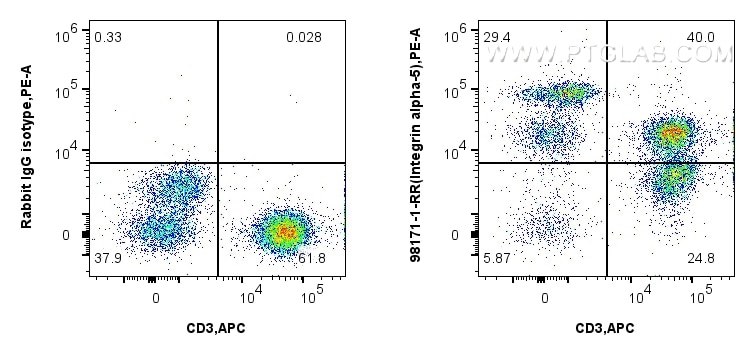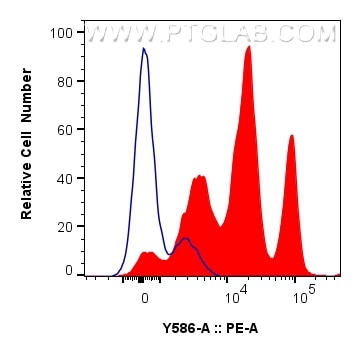Integrin alpha-5/CD49e Rekombinanter Antikörper
Integrin alpha-5/CD49e Rekombinant Antikörper für FC
Wirt / Isotyp
Kaninchen / IgG
Getestete Reaktivität
human
Anwendung
FC
Konjugation
Unkonjugiert
CloneNo.
241685D4
Kat-Nr. : 98171-1-RR
Synonyme
Geprüfte Anwendungen
| Erfolgreiche Detektion in FC | humane PBMCs |
Empfohlene Verdünnung
| Anwendung | Verdünnung |
|---|---|
| This reagent has been tested for flow cytometric analysis. It is recommended that this reagent should be titrated in each testing system to obtain optimal results. | |
| Sample-dependent, check data in validation data gallery | |
Produktinformation
98171-1-RR bindet in FC Integrin alpha-5/CD49e und zeigt Reaktivität mit human
| Getestete Reaktivität | human |
| Wirt / Isotyp | Kaninchen / IgG |
| Klonalität | Rekombinant |
| Typ | Antikörper |
| Immunogen | Rekombinantes Protein |
| Vollständiger Name | integrin, alpha 5 (fibronectin receptor, alpha polypeptide) |
| Berechnetes Molekulargewicht | 115 kDa |
| GenBank-Zugangsnummer | BC008786 |
| Gene symbol | Integrin alpha 5 |
| Gene ID (NCBI) | 3678 |
| Konjugation | Unkonjugiert |
| Form | Liquid |
| Reinigungsmethode | Protein A purfication |
| Lagerungspuffer | PBS with 0.09% sodium azide |
| Lagerungsbedingungen | Store at 2 - 8°C. Stable for one year after shipment. |
Hintergrundinformationen
Integrins are cell adhesion receptors that are heterodimers composed of non-covalently associated alpha and beta subunits. Integrin alpha-5 (ITGA5, also known as CD49e), belongs to the integrin alpha chain family, primarily binds to Integrin beta 1 (ITGB1) to form an α5β1 heterodimer (PMID: 33711961). Integrin α5β1 is a specific receptor of fibronectin through its arginine-glycine-aspartic acid (RGD) binding site (PMID: 19608542). Integrin α5β1 plays roles in cell adhesion, migration and matrix formation, and has emerged as an essential mediator in many human carcinomas (PMID: 33408483).
Protokolle
| PRODUKTSPEZIFISCHE PROTOKOLLE | |
|---|---|
| FC protocol for Integrin alpha-5/CD49e antibody 98171-1-RR | Download protocol |
| STANDARD-PROTOKOLLE | |
|---|---|
| Klicken Sie hier, um unsere Standardprotokolle anzuzeigen |



